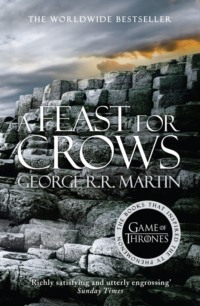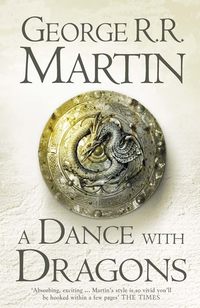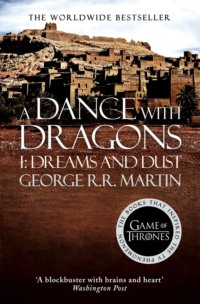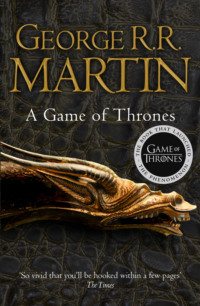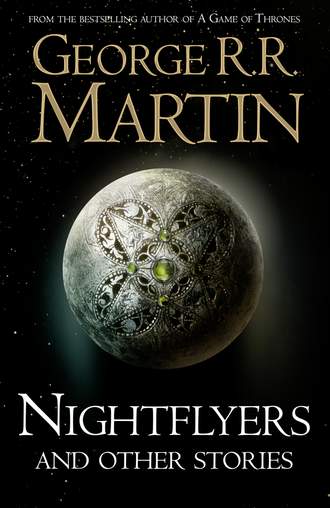
Полная версия
Nightflyers and Other Stories

George R. R. Martin
Nightflyers and Other Stories


Copyright
HarperVoyager
An imprint of HarperCollinsPublishers Ltd
1 London Bridge Street
London SE1 9GF
www.harpercollins.co.uk
First published in Great Britain by HarperCollinsPublishers 2018
This collection copyright © George R.R. Martin 1985
Individual copyrights appear on Copyright Acknowledgements page
Cover illustration © Larry Rostant 2018
Cover design © HarperCollinsPublishers Ltd 2018
George R.R. Martin asserts the moral right to be identified as the author of this work.
A catalogue copy of this book is available from the British Library.
This collection is entirely a work of fiction. The names, characters and incidents portrayed in it are the work of the author’s imagination. Any resemblance to actual persons, living or dead, events or localities is entirely coincidental.
All rights reserved under International and Pan-American Copyright Conventions. By payment of the required fees, you have been granted the non-exclusive, non-transferable right to access and read the text of this e-book on screen. No part of this text may be reproduced, transmitted, down-loaded, decompiled, reverse engineered, or stored in or introduced into any information storage and retrieval system, in any form or by any means, whether electronic or mechanical, now known or hereinafter invented, without the express written permission of HarperCollins.
Source ISBN: 9780008300173
Ebook Edition © May 2018 ISBN: 9780008300180
Version: 2018-05-01
Copyright Acknowledgments
“Nightflyers” copyright © 1980, 1981 by George R. R. Martin. From Binary Star 5 (Dell, 1981). A shorter version of this story originally appeared in Analog, April 1980, copyright © 1980 by the Condé Nast Publications, Inc.
“Override” copyright © 1973 by the Condé Nast Publications, Inc. From Analog, September 1973.
“Weekend In A War Zone” copyright © 1977 by Aurora Publishers, Inc. From Future Pastimes (Aurora, 1977).
“And Seven Times Never Kill Man” copyright © 1975 by the Condé Nast Publications, Inc. From Analog, July 1975.
“Nor the Many-Colored Fires of a Star Ring” copyright © 1976 by George R. R. Martin. From Faster Than Light (Harper & Row, 1976).
“A Song for Lya” copyright © 1974 by the Condé Nast Publications, Inc. From Analog, June 1974.
Dedication
to Gardner Dozois Who fished me out of the slush pile and saved me from those Tubs o’ Fun
Nightflyers
When Jesus of Nazareth hung dying on his cross, the volcryn passed within a year of his agony, headed outward.
When the Fire Wars raged on Earth, the volcryn sailed near Old Poseidon, where the seas were still unnamed and unfished. By the time the stardrive had transformed the Federated Nations of Earth into the Federal Empire, the volcryn had moved into the fringes of Hrangan space. The Hrangans never knew it. Like us they were children of the small bright worlds that circled their scattered suns, with little interest and less knowledge of the things that moved in the gulfs between.
War flamed for a thousand years and the volcryn passed through it, unknowing and untouched, safe in a place where no fires could ever burn. Afterwards, the Federal Empire was shattered and gone, and the Hrangans vanished in the dark of the Collapse, but it was no darker for the volcryn.
When Kleronomas took his survey ship out from Avalon, the volcryn came within ten light years of him. Kleronomas found many things, but he did not find the volcryn. Not then and not on his return to Avalon, a lifetime later.
When I was a child of three Kleronomas was dust, as distant and dead as Jesus of Nazareth, and the volcryn passed close to Daronne. That season all the Crey sensitives grew strange and sat staring at the stars with luminous, flickering eyes.
When I was grown, the volcryn had sailed beyond Tara, past the range of even the Crey, still heading outward.
And now I am old and growing older and the volcryn will soon pierce the Tempter’s Veil where it hangs like a black mist between the stars. And we follow, we follow. Through the dark gulfs where no one goes, through the emptiness, through the silence that goes on and on, my Nightflyer and I give chase.
They made their way slowly down the length of the transparent tube that linked the orbital docks to the waiting starship ahead, pulling themselves hand over through weightlessness.
Melantha Jhirl, the only one among them who did not seem clumsy and ill-at-ease in free fall, paused briefly to look at the dappled globe of Avalon below, a stately vastness in jade and amber. She smiled and moved swiftly down the tube, passing her companions with an easy grace. They had boarded starships before, all of them, but never like this. Most ships docked flush against the station, but the craft that Karoly d’Branin had chartered for his mission was too large, and of too singular in design. It loomed ahead; three small eggs side-by-side, two larger spheres beneath and at right angles, the cylinder of the driveroom between, lengths of tube connecting it all. The ship was white and austere.
Melantha Jhirl was the first one through the airlock. The others straggled up one by one until they had all boarded; five women and four men, each an Academy scholar, their backgrounds as diverse as their fields of study. The frail young telepath, Thale Lasamer, was the last to enter. He glanced about nervously as the others chatted and waited for the entry procedure to be completed. “We’re being watched,” he said.
The outer door was closed behind them, the tube had fallen away; now the inner door slid open. “Welcome to my Nightflyer,” said a mellow voice from within.
But there was no one there.
Melantha Jhirl stepped into the corridor. “Hello,” she said, looking about quizzically. Karoly d’Branin followed her.
“Hello,” the mellow voice replied. It was coming from a communicator grill beneath a darkened viewscreen. “This is Royd Eris, master of the Nightflyer. I’m pleased to see you again, Karoly, and pleased to welcome the rest of you.”
“Where are you?” someone demanded.
“In my quarters, which occupy half of this life-support sphere,” the voice of Royd Eris replied amiably. “The other half is comprised of a lounge-library-kitchen, two sanitary stations, one double cabin, and a rather small single. The rest of you will have to rig sleepwebs in the cargo spheres, I’m afraid. The Nightflyer was designed as a trader, not a passenger vessel. However, I’ve opened all the appropriate passageways and locks, so the holds have air and heat and water. I thought you’d find it more comfortable that way. Your equipment and computer system have been stowed in the holds, but there is still plenty of space, I assure you. I suggest you settle in, and then meet in the lounge for a meal.”
“Will you join us?” asked the psipsych, a querulous hatchet-faced woman named Agatha Marij-Black.
“In a fashion,” Royd Eris said, “in a fashion.”
The ghost appeared at the banquet.
They found the lounge easily enough, after they had rigged their sleepwebs and arranged their personal belongings around their sleeping quarters. It was the largest room in this section of the ship. One end of it was a fully equipped kitchen, well stocked with provisions. The opposite end offered several comfortable chairs, two readers, a holotank, and a wall of books and tapes and crystal chips. In the center was a long table with places set for ten.
A light meal was hot and waiting. The academicians helped themselves and took seats at the table, laughing and talking to each other, more at ease now than when they had boarded. The ship’s gravity grid was on, which went a long way towards making them more comfortable; the queasy awkwardness of their weightless transit was soon forgotten.
Finally all the seats were occupied except for one at the head of the table.
The ghost materialized there.
All conservation stopped.
“Hello,” said the spectre, the bright shade of a lithe, pale-eyed young man with white hair. He was dressed in clothing twenty years out of date; a loose blue pastel shirt that ballooned at his wrists, clinging white trousers with built-in boots. They could see through him, and his own eyes did not see them at all.
“A hologram,” said Alys Northwind, the short, stout xenotech.
“Royd, Royd, I do not understand,” said Karoly d’Branin, staring at the ghost. “What is this? Why do you send us a projection? Will you not join us in person?”
The ghost smiled faintly and lifted an arm. “My quarters are on the other side of that wall,” he said. “I’m afraid there is no door or lock between the two halves of the sphere. I spend most of my time by myself, and I value my privacy. I hope you will all understand, and respect my wishes. I will be a gracious host nonetheless. Here in the lounge my projection can join you. Elsewhere, if you have anything you need, if you want to talk to me, just use a communicator. Now, please resume your meal, and your conversations. I’ll gladly listen. It’s been a long time since I had passengers.”
They tried. But the ghost at the head of the table cast a long shadow, and the meal was strained and hurried.
From the hour the Nightflyer slipped into stardrive, Royd Eris watched his passengers.
Within a few days most of the academicians had grown accustomed to the disembodied voice from the communicators and the holographic spectre in the lounge, but only Melantha Jhirl and Karoly d’Branin ever seemed really comfortable in his presence. The others would have been even more uncomfortable if they had known that Royd was always with them. Always and everywhere, he watched. Even in the sanitary stations, Royd had eyes and ears.
He watched them work, eat, sleep, copulate; he listened untiringly to their talk. Within a week he knew them, all nine, and had begun to ferret out their tawdry little secrets.
The cyberneticist, Lommie Thorne, talked to her computers and seemed to prefer their company to that of humans. She was bright and quick, with a mobile, expressive face and a small hard boyish body; most of the others found her attractive, but she did not like to be touched. She sexed only once, with Melantha Jhirl. Lommie Thorne wore shirts of softly woven metal, and had an implant in her left wrist that let her interface directly with her computers.
The xenobiologist, Rojan Christopheris, was a surly, argumentative man, a cynic whose contempt for his colleagues was barely kept in check, a solitary drinker. He was tall and stooped and ugly.
The two linguists, Dannel and Lindran, were lovers in public, constantly holding hands and supporting each other. In private they quarreled bitterly. Lindran had a mordant wit and liked to wound Dannel where it hurt the most, with jokes about his professional competence. They sexed often, both of them, but not with each other.
Agatha Marij-Black, the psipsych, was a hypochondriac given to black depressions, which worsened in the close confines of the Nightflyer.
Xenotech Alys Northwind ate constantly and never washed. Her stubby fingernails were always caked with black dirt, and she wore the same jumpsuit for the first two weeks of the voyage, taking it off only for sex, and then only briefly.
Telepath Thale Lasamer was nervous and temperamental, afraid of everyone around him, yet given to bouts of arrogance in which he taunted his companions with thoughts he had snatched from their minds.
Royd Eris watched them all, studied them, lived with them and through them. He neglected none, not even the ones he found the most distasteful. But by the time the Nightflyer had been lost in the roiling flux of stardrive for two weeks, two of his riders had come to engage the bulk of his attention.
“Most of all, I want to know the why of them,” Karoly d’Branin told him one false night the second week out from Avalon.
Royd’s luminescent ghost sat close to d’Branin in the darkened lounge, watching him drink bittersweet chocolate. The others were all asleep. Night and day are meaningless on a starship, but the Nightflyer kept the usual cycles and most of the passengers followed them. Old d’Branin, administrator, generalist, and mission leader, was the exception; he kept his own hours, preferred work to sleep, and liked nothing better than to talk about his pet obsession, the volcryn he hunted.
“The if of them is important as well, Karoly,” Royd answered. “Can you truly be certain these aliens of yours exist?”
“I can be certain,” Karoly d’Branin said, with a broad wink. He was a compact man, short and slender, iron grey hair carefully styled and his tunic almost fussily neat, but the expansiveness of his gestures and the giddy enthusiasms to which he was prone belied his sober appearance. “That is enough. If everyone else were certain as well, we would have a fleet of research ships instead of your little Nightflyer.” He sipped at his chocolate and sighed with satisfaction. “Do you know the Nor T’alush, Royd?”
The name was strange, but it took Royd only a moment to consult his library computer. “An alien race on the other side of human space, past the Fyndii worlds and the Damoosh. Possibly legendary.”
D’Branin chuckled. “No, no, no! Your library is out of date, my friend, you must supplement it the next time you visit Avalon. Not legends, no, real enough, though far away. We have little information about the Nor T’alush, but we are sure they exist, though you and I may never meet one. They were the start of it all.”
“Tell me,” Royd said. “I am interested in your work, Karoly.”
“I was coding some information into the Academy computers, a packet newly arrived from Dam Tullian after twenty standard years in transit. Part of it was Nor T’alush folklore. I had no idea how long that had taken to get to Dam Tullian, or by what route it had come, but it did not matter – folklore is timeless anyway, and this was fascinating material. Did you know that my first degree was in xenomythology?”
“I did not. Please continue.”
“The volcryn story was among the Nor T’alush myths. It awed me; a race of sentients moving out from some mysterious origin in the core of the galaxy, sailing towards the galactic edge and, it was alleged, eventually bound for intergalactic space itself, meanwhile always keeping to the interstellar depths, no planetfalls, seldom coming within a light year of a star.” D’Branin’s grey eyes sparkled, and as he spoke his hands swept enthusiastically to either side, as if they could encompass the galaxy. “And doing it all without a stardrive, Royd, that is the real wonder! Doing it in ships moving only a fraction of the speed of light! That was the detail that obsessed me! How different they must be, my volcryn—wise and patient, long-lived and long-viewed, with none of the terrible haste and passion that consume the lesser races. Think how old they must be, those volcryn ships!”
“Old,” Royd agreed. “Karoly, you said ships. More than one?”
“Oh, yes,” d’Branin said. “According to the Nor T’alush, one or two appeared first, on the innermost edges of their trading sphere, but others followed. Hundreds of them, each solitary, moving by itself, bound outward, always outward. The direction was always the same. For fifteen thousand standard years they moved among the Nor T’alush stars, and then they began to pass out from among them. The myth said that the last volcryn ship was gone three thousand years ago.”
“Eighteen thousand years,” Royd said, adding. “Are the Nor T’alush that old?”
“Not as star-travellers, no,” d’Branin said, smiling. “According to their own histories, the Nor T’alush have only been civilized for about half that long. That bothered me for a while. It seemed to make the volcryn story clearly a legend. A wonderful legend, true, but nothing more.
“Ultimately, however, I could not let it alone. In my spare time I investigated, crosschecking with other alien cosmologies to see whether this particular myth was shared by any races other than the Nor T’alush. I thought perhaps I could get a thesis out of it. It seemed a fruitful line of inquiry.
“I was startled by what I found. Nothing from the Hrangans, or the Hrangan slave races, but that made sense, you see. Since they were out from human space, the volcryn would not reach them until after they had passed through our own sphere. When I looked in, however, the volcryn story was everywhere.” D’Branin leaned forward eagerly. “Ah, Royd, the stories, the stories!”
“Tell me,” Royd said.
“The Fyndii call them iy-wivii, which translates to something like void-horde or dark-horde. Each Fyndii horde tells the same story, only the mindmutes disbelieve. The ships are said to be vast, much larger than any known in their history or ours. Warships, they say. There is a story of a lost Fyndii horde, three hundred ships under rala-fyn, all destroyed utterly when they encountered an iy-wivii. This was many thousands of years ago, of course, so the details are unclear.
“The Damoosh have a different story, but they accept it as literal truth – and the Damoosh, you know, are the oldest race we’ve yet encountered. The people of the gulf, they call my volcryn. Lovely stories, Royd, lovely! Ships like great dark cities, still and silent, moving at a slower pace than the universe around them. Damoosh legends say the volcryn are refugees from some unimaginable war deep in the core of the galaxy, at the very beginning of time. They abandoned the worlds and stars on which they had evolved, sought true peace in the emptiness between.
“The gethsoids of Aath have a similar story, but in their tale that war destroyed all life in our galaxy, and the volcryn are gods of a sort, reseeding the worlds as they pass. Other races see them as god’s messengers, or shadows out of hell warning us all to flee some terror soon to emerge from the core.”
“Your stories contradict each other, Karoly.”
“Yes, yes, of course, but they all agree on the essentials – the volcryn, sailing out, passing through our short-lived empires and transient glories in their ancient eternal sublight ships. That is what matters! The rest is frippery, ornamentation; we will soon know the truth of it. I checked what little was known about the races said to flourish further in still, beyond even the Nor T’alush – civilizations and peoples half legendary themselves, like the Dan’lai and the ullish and the Rohenna’kh – and where I could find anything at all, I found the volcryn story once again.”
“The legend of the legends,” Royd suggested. The spectre’s wide mouth turned up in a smile.
“Exactly, exactly,” d’Branin agreed. “At that point, I called in the experts, specialists from the Institute for the Study of Non-Human Intelligence. We researched for two years. It was all there, in the libraries and memories and matrices of the Academy. No one had ever looked before, or bothered to put it together.
“The volcryn have been moving through the manrealm for most of human history, since before the dawn of spaceflight. While we twist the fabric of space itself to cheat relativity, they have been sailing their great ships right through the heart of our alleged civilization, past our most populous worlds, at stately slow sublight speeds, bound for the Fringe and the dark between the galaxies. Marvelous, Royd, marvelous!”
“Marvelous!” Royd agreed.
Karoly d’Branin drained his chocolate cup with a swig, and reached out to catch Royd’s arm, but his hand passed through empty light. He seemed disconcerted for a moment, before he began to laugh at himself. “Ah, my volcryn. I grow overenthused, Royd. I am so close now. They have preyed on my mind for a dozen years, and within the month I will have them, will behold their splendor with my own weary eyes. Then, then, if only I can open communication, if only my people can reach ones so great and strange as they, so different from us – I have hopes, Royd, hopes that at last I will know the why of it!”
The ghost of Royd Eris smiled for him, and looked on through calm transparent eyes.
Passengers soon grow restless on a starship under drive, sooner on one as small and spare as the Nightflyer. Late in the second week, the speculation began in deadly earnest.
“Who is this Royd Eris, really?” the xenobiologist, Rojan Christopheris, complained one night when four of them were playing cards. “Why doesn’t he come out? What’s the purpose of keeping himself sealed off from the rest of us?”
“Ask him,” suggested Dannel, the male linguist.
“What if he’s a criminal of some sort?” Christopheris said. “Do we know anything about him? No, of course not. D’Branin engaged him, and d’Branin is a senile old fool, we all know that.”
“It’s your play,” Lommie Thorne said.
Christopheris snapped down a card. “Setback,” he declared, “you’ll have to draw again.” He grinned. “As for this Eris, who knows that he isn’t planning to kill us all.”
“For our vast wealth, no doubt,” said Lindran, the female linguist. She played a card on top of the one Christopheris had laid down. “Ricochet,” she called softly. She smiled.
So did Royd Eris, watching.
Melantha Jhirl was good to watch.
Young, healthy, active, Melantha Jhirl had a vibrancy about her the others could not match. She was big in every way; a head taller than anyone else on board, large-framed, large-breasted, long-legged, strong, muscles moving fluidly beneath shiny coal-black skin. Her appetites were big as well. She ate twice as much as any of her colleagues, drank heavily without ever seeming drunk, exercised for hours every day on equipment she had brought with her and set up in one of the cargo holds. By the third week out she had sexed with all four of the men on board and two of the other women. Even in bed she was always active, exhausting most of her partners. Royd watched her with consuming interest.
“I am an improved model,” she told him once as she worked out on her parallel bars, sweat glistening on her bare skin, her long black hair confined in a net.
“Improved?” Royd said. He could not send his projection down to the holds, but Melantha had summoned him with the communicator to talk while she exercised, not knowing he would have been there anyway.
She paused in her routine, holding her body straight and aloft with the strength of her arms and her back. “Altered, captain,” she said. She had taken to calling him captain. “Born on Prometheus among the elite, child of two genetic wizards. Improved, captain. I require twice the energy you do, but I use it all. A more efficient metabolism, a stronger and more durable body, an expected lifespan half again the normal human’s. My people have made some terrible mistakes when they try to radically redesign humanity, but the small improvements they do well.”
She resumed her exercises, moving quickly and easily, silent until she had finished. When she was done, she vaulted away from the bars and stood breathing heavily for a moment, then crossed her arms and cocked her head and grinned. “Now you know my life story, captain,” she said. She pulled off the net to shake free her hair.
“Surely there is more,” said the voice from the communicator.
Melantha Jhirl laughed. “Surely,” she said. “Do you want to hear about my defection to Avalon, the whys and wherefores of it, the trouble it caused my family on Prometheus? Or are you more interested in my extraordinary work in cultural xenology? Do you want to hear about that?”
“Perhaps some other time,” Royd said politely. “What is that crystal you wear?”
It hung between her breasts ordinarily; she had removed it when she stripped for her exercises. She picked it up again and slipped it over her head; a small green gem laced with traceries of black, on a silver chain. When it touched her Melantha closed her eyes briefly, then opened them again, grinning. “It’s alive,” she said. “Haven’t you ever seen one? A whisperjewel, captain. Resonant crystal, etched psionically to hold a memory, a sensation. The touch brings it back, for a time.”



